
The number of handheld ultrasound machines over the past 5 years has increased significantly. Initially the quality of the image was poor, however over recent years this has changed and there are now a few companies leading the way.
For many years the Philips Lumify has been considered the market leader in handheld machines. It has been setting the standards for this market sector. However, this sector is getting more crowded and many new machines have been launched over the past few years.
We recently reviewed the Clarius version 2 handheld machine which is a significant step up in image quality from the first version. Overall, we were impressed with the new Clarius and consider it to be in the same league as the Lumify. This is a league of their own in our opinion, other handhelds machines do not have the required image quality for MSK scanning, including the new the Butterfly IQ (which we recently reviewed here).
Following our Clarius version 2 review, we wanted to get the Lumify back to have a closer look and spend some more time reviewing its features and image quality in preparation for our head to head; the Philips Lumify versus the Clarius version 2!

We first tried the Philips Lumify a few years back and were immediately impressed by the image quality for a handheld device. But, it is important to remember this is all relative. The image quality is very good for a handheld device (costing approximately £6000), it is not very good when compared to more expensive machines which have superior image quality. For example, it is not comparable with a GE Logiq-e, Samsung HM70A, Konica Minolta SONIPLUS HS1 or the Alpinion ECubei7. These are portable, lap top machines but they do cost significantly more (approximately £15,000 plus)!
So, we must not get too carried away! Follow this link for more information about portable lap-top machine and what to look for in an ultrasound machine.
As we always say you pay for what you get with ultrasound machines. A £5000 machine will not give you the same image quality as a £15000 machine…fact!
Let’s have a closer look at the Phllips Lumify. We will go through some of the key features of the machine:
1/ Probe
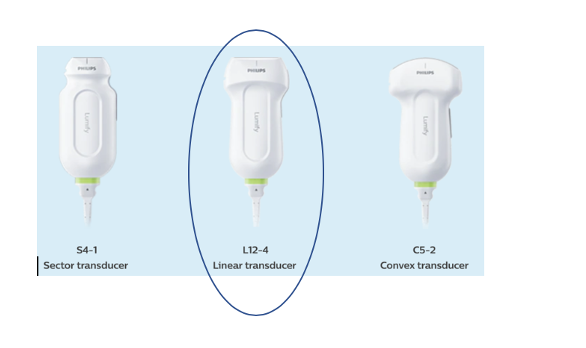
The Lumify has a variety of probes; S4-1, L12-4 and the C5-2. There is no hockey stick probe. As a MSK practitioner you would purchase the L12-4 linear probe which is comparable to most MSK linear probes and provides the required frequency for MSK scanning. The L12-4 probe scans to 12cm, not that you would get a good picture that deep!
The L12-4 probe is basically the same as a normal ultrasound probe and is very easy and comfortable to handle. It is very light and easy to manoeuvre. Dare we say it is so light it feels a bit cheap!
The probe connects to the screen using a MicroB USB transducer with replaceable cable. Most transducers fail due to wiring issues, so this is easily replaced (but at a cost I am sure). It is easy to connect and the wire is long enough for scanning. There are no probe buttons to freeze or save images /cine loops. This is not a big deal in my opinion but some clinician’s do like the option especially if you are carrying out guided procedures for example. Maybe a small feature to add for the version 2!
2/ Compatibility
The Lumify app is compatible with Android smart devices (tablets and phones) via the Google play store. The Lumify is not compatible with Apple products, unlike the Clarius and Butterfly. So, if you are an Apple enthusiast (which many are) this maybe an issue. Here is a full list of the compatible devices. The devices approved by Philips range from 5.5 inch phones to 18 inch tablets, both Wi-Fi and cellular.
In the UK, the Lumify comes with a compatible tablet of your choice as part of the price. We would suggest you go for a tablet with the largest screen to ensure you get an adequately sized image. Many have chosen the Samsung Galaxy Tab S3 (9.7 inch screen).
You can use your Lumify transducer with as many devices as you would like. You just have to register the probe the first time you connect it to a new device.
2/ Userability
Overall the Lumify is very intuitive and straight forward to use. You will not need to get the instruction manual out to start scanning. The gain, depth, save, freeze and recording cine loops are very simple and easy to adjust using the touch screen . Maximum clip length is 10 seconds. Ideally, this would be a little longer.
The pre-sets are easy to find and require little adjustment for each anatomical region. There is no adjustable focus zone on the Lumify. The Lumify automatically adjusts the number and position of focal zones based on the preset application, colour box position, and depth. The MSK pre-sets have been optimised for each anatomical location and do not require any adjustments other than gain and depth. If you are a beginner to ultrasound this makes the Lumify very easy to use with few adjustments required to optimise the image.
The frequency is automatically adjusted by the chosen depth and pre-set. A more technical explanation is the Lumify uses broadband transducers which means they send and receive the full frequency range of the probe 12-3mHZ and stitch these together for uniform penetration and ease of use. The preset and depth will dictate how this is displayed and no direct control of the frequency is available for the user.
As an experienced sonographer having the option to adjust frequency would be preferred however as a beginner it gives you one less thing to think about!
2/ Battery life
This can vary on the tablet/device you are using. The battery life is approximately 6 hours which is above average for a handheld device. You simply plug in the device to charge as you would with any tablet. The probe does not need charging. The probe uses the battery life of the device. However, you cannot charge the battery and scan at the same time.
3/ Image quality (linear L12-4 probe)
Here is a selection of images at varying depth using the MSK pre-set provided on Phillips Lumify.
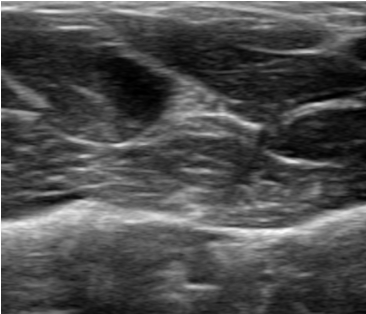
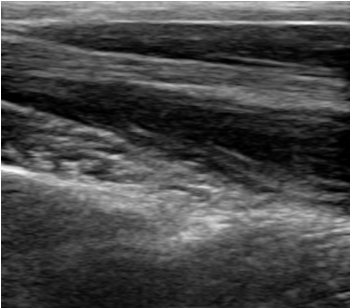
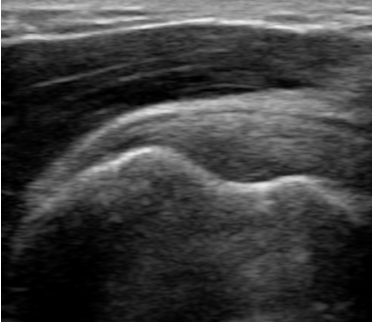
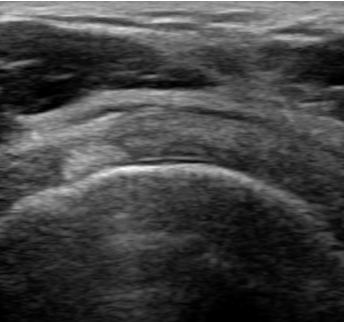
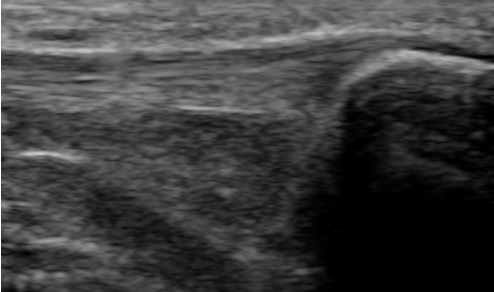
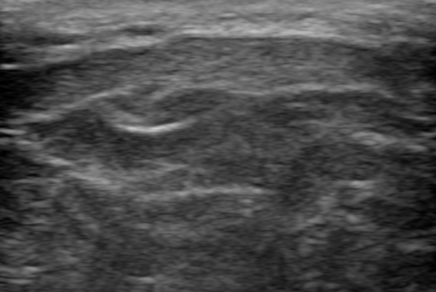
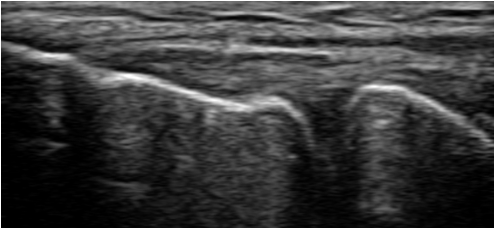
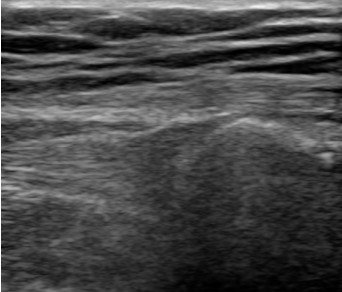
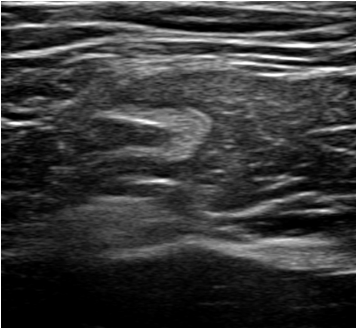
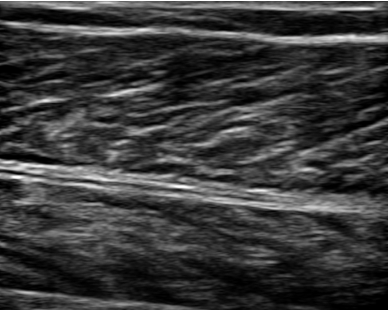
“Image quality is the most important component of a machine”.
Considering the price and portability of the machine the images are impressive. Certainly, as the depth increases the image quality, particularly the spatial resolution reduces more than a more expensive machine. This is not surprising and to be expected on a machine in this price bracket.
Our next blog is going to be a handheld machine head to head between the Phillips Lumify and Clarius version 2. But you can make your own mind up. The Lumify images used in this review above are the same anatomical structure as the images in our recent Clarius version 2 review which can be read here. What do you think?
3/ Ease of use – Connectivity and storage
When you have downloaded the app from Google Play, the set up and start up is very straight forward and intuitive. It is one touch to start an ultrasound exam.
You can export exams and images to a DICOM PACS, to a network share, or to a local source. The images are not automatically uploaded into the cloud, unlike the Clarius version 2 which has a seamless cloud storage with excellent file management and sharing options . The Lumify can integrate with your PACS system or other cloud storage options (see image below).

It is very easy to export the scans from the machine via email but you are limited to file size. You can only send a few videos on the same email. We were able to send 4 scans of 4 seconds videos. Anymore than this and you will have to divide them into separate emails, which is a little annoying.
Lumify has teamed up with Reacts to provide a ‘tele-ultrasound’ offering allowing real time collaboration. Reacts (Remote, Augmented Communication, Training and Supervision) is a secure, integrated platform with unparalleled interactive tools to suit the multiple collaborative needs of healthcare professionals. React allows you to simultaneously stream your live ultrasound images, video and audio from your Lumify to a colleague or tutor. This a pretty cool feature and could be very useful for online teaching and sharing and receiving immediate feedback on your image and ensuring you have arrived at the correct diagnosis.
We tested this (see image below) and it was very straight forward to use, however it kept dropping out. Both parties have to have excellent (very, very fast) broadband for this to work seamlessly.
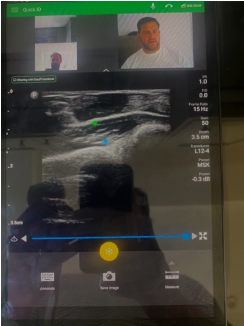
This interactive offering is a great feature of the Lumify and is becoming the norm with all many new handheld devices including the Clarus version 2 and the Butterfly. Patient safety and confidentiality is of paramount importance and this is potentially a GDPR minefield if you are using this to share patient data/images.
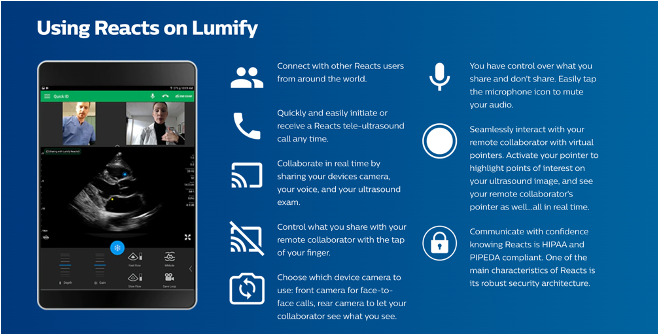
It is also possible with a Google Chromecast to link your Android device to a central display. This is a nice feature for education and supervision.
4/ Cost
The Philips Lumify costs £4,999 per transducer exclusive of VAT or £5998.80 inclusive of VAT. They also offer a multi-transducer discounts when purchased at the same time; 2 x probes £9,500 + VAT (£11,400 inclusive of VAT) and 3 x probes - £13,500 + VAT (£16,200 inclusive of VAT).
So, for the full system with three probes it is over £16,000 !!! This does not represent good value for money. However, as a MSK practitioner you will only require one probe (the L12-4 linear probe) and so is good value for money.
With every purchase you get:

The only ongoing costs is the REACTS licence. After the initial free year it is $84 (£64) per user/per year (https://reacts.com/en/plans/). This provides 2GB of storage.
Other features:
5/ Needle visualisation
We tested guiding a needle on meat specimens (not humans)! The visualisation of the needle (25G and 21G) was straight forward and would be very suitable for straightforward superficial injections such as acromioclavicular and ankle joint and sub-acromial bursa. As the probe feels like a normal ultrasound probe (but a bit lighter) it takes no time to get use to using it. We cannot comment on deep injections such as the hip or shoulder joint as we have not been able to try it on patients.
The Lumify does not have needle visualisation, unlike the Clarius version 2. Most experienced clinician’s do not use needle visualisation and so this is not an issue. However, if you are new to guided injections then this feature can be useful to get started.
5/ Colour Doppler
The Lumify only has a colour Doppler as a standard feature. It does not have the option of power Doppler. We have not had the opportunity to directly compare the colour Doppler to other handheld or portable machines. On the Lumify you have a fast flow and a slow flow option. These features are one button and simple to use.
Fast Flow is optimized for faster blood flow conditions within each exam type (e.g. arterial flow). The slow flow setting eliminates the need to manually adjust the scale while using color flow imaging: Slow flow is optimized for slower blood flow conditions within each exam type (e.g. venous flow). You can further optimize fast/slow flow by adjusting the colour gain control.
If you are planning on scanning lots of tendon pathology and are interested in the amount or presence of neovascularisation or you are a rheumatologist assessing for early inflammatory arthritis then the absence of power Doppler may limit your diagnostic ability. If you are interested in this group of patients, we would suggest you directly compare the colour Doppler to other machines with power Doppler before purchasing.
6/ Elastography
This is not available on the Lumify.
Conclusion
The Philips Lumify is a cool bit of kit and over the last few years has been setting the standards for handheld machines. It is competitively priced and is easy to use. The Lumify is a ‘point and shoot’ ultrasound machine with very good image quality for a machine priced at £6000.
Our next blog will be a head to head of the Lumify and Clarius version 2 – currently the two best handheld machines on the market in our opinion…WTS!!
If you have any questions about this blog or would like to discuss any aspect of ultrasound please contact chris@ultrasoundtraining.co.uk.
For more information about the Phillips Lumify handheld machine Email: tracey.fitzpatrick@philips.com